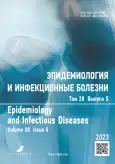The course of COVID-19 with the development of “shock organs — lungs and heart”
- Authors: Alpidovskaya O.V.1
-
Affiliations:
- Chuvash State University named after I.N. Ulyanov
- Issue: Vol 28, No 5 (2023)
- Pages: 331-336
- Section: CASE REPORTS
- URL: https://journals.rcsi.science/1560-9529/article/view/148250
- DOI: https://doi.org/10.17816/EID492322
- ID: 148250
Cite item
Abstract
The article presents a clinical and morphological description of a case involving death upon admission to a hospital, marked by developed sepsis and septic shock caused by the addition of bacterial flora. It also presents a clinical and morphological description of the development of “shock organs — lungs and heart” after infection with SARS-CoV-2.
A 38-year-old patient was hospitalized diagnosed with severe coronavirus infection, leading to shock. Complications arising from the underlying disease included bilateral viral interstitial pneumonia. Virological analysis of throat and nose swap samples confirmed SARS-CoV-2 coronavirus RNA. The patient’s condition, evaluated on the NEWS2 scale, scored 18 points. C-reactive protein levels were measured at 117 mg/l, and procalcitonin level was 9 ng/ml. Despite treatment efforts, the patient did not survive. Sectional examination in the lungs showed focal atelectasis of various sizes, edema with a large number of red blood cells. In the alveoli, there are fibrin threads and “hyaline membranes” — blood stasis in the microcirculatory bed. In the heart, uneven blood filling in vessels, subendocardial hemorrhages, dystrophic and necrobiotic changes in cardiomyocytes, small foci of necrosis, fragmentation of cardiomyocytes, and intermuscular edema were noted. In the described case, the patient developed an infectious-toxic shock with severe changes in the lungs and heart attributed to a SARS-CoV-2 infection. These changes were intensified because of the addition and activation of bacterial flora due to a violation of the barrier function of the lung epithelium, leading to its complete destruction.
Full Text
##article.viewOnOriginalSite##About the authors
Olga V. Alpidovskaya
Chuvash State University named after I.N. Ulyanov
Author for correspondence.
Email: olavorobeva@mail.ru
ORCID iD: 0000-0003-3259-3691
MD, Cand. Sci. (Med.), Associate Professor
Russian Federation, 45 Moskovsky prospect, 428015 CheboksaryReferences
- Bitsadze VO, Khizroeva JK, Makatsariya AD, et al. COVID-19, septic shock and syndrome of disseminated intravascular coagulation syndrome. Part 1. Annals of the Russian Academy of Medical Sciences. 2020;75(2):118–128. (In Russ). doi: 10.15690/vramn1335
- Eisenreich W, Heesemann J, Rudel T, Goebel W. Metabolic host responses to infection by intracellular bacterial pathogens. Front Cell Infect Microbiol. 2013;3:24. doi: 10.3389/fcimb.2013.00024
- Zhang H, Zhou P, Wei Y, et al. Histopathologic changes and SARS-CoV-2 immunostaining in the lung of a patient with COVID-19. Ann Intern Med. 2020;172:629–632. doi: 10.7326/M20-0533
- Abdurahimov AKh, Khegay LN, Yusupova ShK. COVID-19 and its complications. Re-health Journal. 2021;4(12):61–74. Available at: https://cyberleninka.ru/article/n/covid-19-i-ego-oslozhneniya (In Russ). Accessed: 30.03.2023.
- Vorobeva OV. Changes in organs in COVID-19 infection with septicopyemia. Profilakticheskaya meditsina. 2021;24(10):89-93. (In Russ). doi: 10.17116/profmed20212410189
- Vorobeva OV, Romanova LP. A case of abscessed pneumonia due to COVID-19 infection in a young patient. Russian Journal of Infection and Immunity. 2022;12(4):779–783. (In Russ). doi: 10.15789/2220-7619-ACO-1582
- Dmitriev IV, Dorosevich AE, Abrosimov SJu. Features of shock pathomorphology. Bulletin of the Smolensk State Medical Academy. 2021;20(2):142–149. (In Russ). doi: 10.37903/vsgma.2021.2.20
Supplementary files







